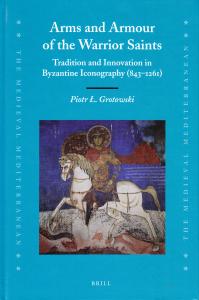Arms and Armour of the Warrior Saints. Tradition and Innovation in Byzantine Iconography (843–1261)
CODICE: ISBN 9004185488 EAN 9789004185487
AUTORE/CURATORE/ARTISTA :
Author: Piotr Ł. Grotowski Translated by: Richard Brzezinski
EDITORE/PRODUTTORE : Brill
COLLANA/SERIE : The Medieval Mediterranean, 87
DISPONIBILITA': In esaurimento
TITOLO/DENOMINAZIONE:
Arms and Armour of the Warrior Saints. Tradition and Innovation in Byzantine Iconography (843–1261)
PREZZO : EUR 272,00€
CODICE :
ISBN 9004185488
EAN 9789004185487
AUTORE/CURATORE/ARTISTA :
Author: Piotr Ł. Grotowski Translated by: Richard Brzezinski
EDITORE/PRODUTTORE:
Brill
COLLANA/SERIE:
The Medieval Mediterranean, 87
ANNO:
2010
DISPONIBILITA':
In esaurimento
CARATTERISTICHE TECNICHE:
704 pages
141 black and white illustrations, 33 color illustrations
Hardback
cm 16,5 x 24,5 x 3,5
gr 1220
DESCRIZIONE:
Publisher's description and from the back cover:
The question of the independence of Byzantine iconography continues to draw attention. Following extensive research on the persistence of Classical motifs in Byzantine art, interest has recently turned to the originality of the latter and its reliability as a historical source. This study examines whether military equipment (armour, weapons, insignia and costume) shown in images of the warrior saints reflects items actually used in the mid-Byzantine Army or merely repeats Classical forms. Such representations are compared with documentary evidence gathered chiefly from Byzantine military manuals. The author demonstrates that military equipment, being a vital branch of material culture subject to constant evolution, provides a good indicator of iconographic innovation in the art of Byzantium.
Contents:
page IX List of illustrations
XIX Acknowledgements
XXI Translator's Note
XXIII Conventions used in this book
1 INTRODUCTION
4 Scope of Research
4 Time-frame
6 Selection of material
11 State of Research
11 Research on the development of the cult and iconography of warrior saints
14 Research on the military equipment of the Middle Byzantine army
19 Chapter One. SOURCES
19 Material Sources (Archaeological)
34 Written Sources
34 Military treatises (Taktika and Strategika)
40 Taktikons and Books of Ceremony
42 Lexicography
43 Historiography
50 Literature
51 Non-Greek sources
53 Iconographical Sources
57 Chapter Two. ORIGINS OF THE IMAGE OF THE WARRIOR SAINT
63 God's Peace and Holy War in Christian Doctrine
74 The Image of the Warrior Saint in Art Before Iconoclasm
74 The type of the mounted warrior saint
86 The type of the warrior saint on foot
92 Warrior Saints and Ancient Gods
98 Heavenly supporters of the army
104 The Imperial Cohort
107 From local cult to nationwide image of the patron warrior saint
117 The two saint Theodores
121 Conclusions
125 Chapter Three. ICONOGRAPHY OF THE COSTUME AND ARMOUR OF THE WARRIOR SAINTS
125 Armour
125 Corselet
129 The 'muscled' cuirass
133 Scale body armour
137 The lamellar cuirass (klibanion)
151 Soft armour (neurika, lorikion psilos)
154 The zaba and lorikion and the problem of the mail-shirt
162 Other elements of armour
162 Lower body protection (pteryges and kremasmata)
166 Kabadion (and skaramangion)
170 Shoulder-guards and sleeves (manikia)
174 Lower tunic (himation, peristethidia)
176 Shoulder pennants (phlamuliskia)
177 Epilorikion (epanoklibanion, epithorakion)
179 The Symbolism of Armour
183 Protection for Arms and Legs
183 Manikellia (cheiromanika, cheiropsella)
187 Armour for the lower leg (chalkotouba, podopsella)
191 Footwear (pedila)
191 Shoes (tzangia)
193 Tall boots (krepides, hypodemata)
198 Bast sandals-servoula (mouzakia) and kampagia
203 Trousers (toubia, anaxyrides)
208 The Shield
215 Construction of the shield
225 Shape of the shield
225 Circular and oval shields (thyreos, skoutarion, pelta, parma)
231 The kite-shaped shield
234 The elongated triangular shield and the Gothic or heater shield
236 Devices on the shields warrior saints
238 Ornamental motifs
240 Signs (simeia) for identifying military units
241 Inscriptions
243 Religious (and apotropaic) symbols
246 Proto-heraldic devices
250 Symbolism and customs related to the shield
254 The Cloak (Mandyas)
255 The chlamys or officer's cloak
265 Cloaks of junior offcers and ordinary soldiers (the sagion)
271 Insignia
271 Fibula (Kornoukopion, porpe)
277 The officer's sash (diadema, zone stratiotike)
281 Tablion
284 Symbolic insignia-diadem and tiara
285 Diadem
293 Tiara
294 The torque (maniakion)
300 Unusual Variants of Uniform in the Iconography of the Warrior Saints
301 Warrior saints in officer's parade uniform
307 The warrior saint in a provincial guise (in a kabadion)
309 Continuarion of the Early Byzantine image of the equestrian saint in a tunic
310 The fantastical image of the holy warrior
311 Conclusions
313 Chapter Four. WEAPONS IN THE ICONOGRAPHY OF THE WARRIOR SAINTS
313 The Lance or Spear of the Warrior Saint
318 Types of Shafted Weapon in Byzantium
318 Javelins and spears (verytta, akontion, rhiptarion)
320 The heary infantry pike (menaulion)
323 Lance and spear (dory, kontarion, longche)
334 The lance as a sign of status and a symbolic weapon
334 The Crux hastata
340 Military flags (phlamoulon, bandon)
342 Edged Weapons
342 The sword (spatha, xiphos)
357 The palash (proto-sabre?)-paramerion
360 Symbolism of the sword
367 Other Types of Weapons of the Warrior Saints
376 Conclusions
379 Chapter Five. EQUESTRIAN EQUIPMENT
379 Horse Tack
379 Stirrups (skala, anavoleus)
383 Saddle and saddlecloth (sella and ephestris)
386 Other elements and riding equipment
392 Spurs
395 The Horse Armour Problem
397 Conclusions
399 Conclusions
405 Bibliography
447 Indices
Illustration Section
GENERE: Libri ,Saggi ,



